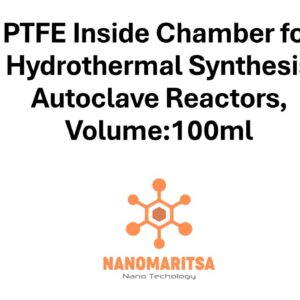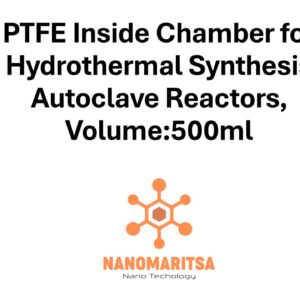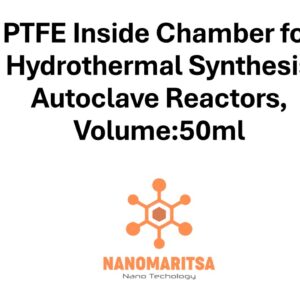Hydrothermal Synthesis Autoclave Reactor with PTFE Lined Vessel 100 ml
€272.00
CompareHydrothermal Synthesis Autoclave Reactor with PTFE Lined Vessel (100 ml) is a laboratory equipment designed for conducting hydrothermal synthesis reactions. These reactions involve high-temperature and high-pressure conditions in an aqueous environment, allowing for the growth or synthesis of materials that are typically difficult to form under standard conditions. Below is an overview of its key features, properties, and applications:
1. Key Features:
- Hydrothermal Synthesis: The reactor is designed to facilitate hydrothermal synthesis, which involves heating a solution or suspension within a sealed vessel to high temperatures and pressures. This method promotes the formation of materials such as nanoparticles, crystals, and other advanced materials by allowing reactions to occur in water at elevated temperatures (typically between 150°C to 250°C).
- PTFE Lined Vessel: The reactor features a vessel lined with PTFE (polytetrafluoroethylene), a highly inert and non-reactive material. PTFE is known for its chemical resistance, high-temperature tolerance, and low friction properties, making it ideal for containing aggressive or corrosive chemicals during synthesis.
- Volume (100 ml): The reactor has a capacity of 100 milliliters (ml), making it suitable for larger-scale reactions compared to smaller versions like the 50 ml reactor. This size is ideal for small-scale research, development, and material synthesis where a moderate volume of reagents is required.
- Pressure and Temperature Control: The reactor is designed to handle high pressure (often up to 200-300 bar) and high temperatures, making it suitable for the demanding conditions of hydrothermal synthesis.
- Safety Features: Hydrothermal autoclave reactors are equipped with safety mechanisms to prevent accidents due to high pressure and temperature. The PTFE lining also helps minimize the risk of chemical contamination or leakage.
2. Properties:
- Chemical Inertness: The PTFE lining ensures the reactor remains inert to most chemicals, preventing unwanted reactions between the vessel and reactants. This is particularly important when dealing with reactive solvents or acids.
- High Temperature and Pressure Resistance: The reactor can withstand temperatures up to 250°C and pressures in the range of 200-300 bar, making it ideal for hydrothermal reactions where such extreme conditions are needed for material formation or crystallization.
- Uniform Reaction Environment: The sealed environment ensures uniform temperature and pressure conditions, which is crucial for reproducible and controlled reactions, leading to consistent material properties.
- Versatility: The reactor can be used for a wide range of hydrothermal reactions, including the synthesis of nanoparticles, metal oxides, ceramics, and other inorganic compounds.
3. Applications:
- Nanomaterial Synthesis: The reactor is commonly used in the synthesis of nanoparticles and nanomaterials, which can be applied in fields such as electronics, energy storage, and catalysis.
- Crystal Growth: Hydrothermal conditions are ideal for growing single crystals or polycrystals of various materials, including metal oxides, semiconductors, and other inorganic compounds.
- Catalysis and Chemical Reactions: The reactor is suitable for producing catalytic materials or for carrying out chemical reactions that require high-temperature and high-pressure conditions.
- Energy Materials: Hydrothermal synthesis is often used to prepare materials for energy storage and conversion, such as lithium-ion battery anodes, supercapacitors, and fuel cells.
- Environmental Applications: This reactor can be used for research in the development of materials for water treatment, pollution control, or environmental remediation.
- Ceramics and Advanced Materials: The reactor is ideal for the synthesis of advanced ceramics and composites, which can be used in high-performance applications such as sensors, coatings, and electronic devices.
4. Handling and Safety:
- Toxicity and Corrosiveness: Although the PTFE lining provides excellent chemical resistance, it is important to carefully choose reagents that are compatible with the material. Some chemicals may pose health risks, so proper safety protocols should be followed when handling the reactor.
- Pressure and Temperature Safety: Since the reactor operates under high pressure and temperature, it is essential to adhere to the manufacturer’s guidelines and ensure that the reactor is properly sealed before use. Regular maintenance and inspection of seals and gaskets are also crucial.
- Storage: The reactor should be stored in a cool, dry place, away from direct sunlight or extreme temperature fluctuations. After use, ensure that the reactor is thoroughly cleaned to prevent chemical buildup or contamination.
- Precautions: Always wear appropriate personal protective equipment (PPE) such as gloves, goggles, and lab coats when handling the reactor. It is recommended to work in a well-ventilated area or a fume hood to avoid exposure to any vapors or fumes generated during the reaction.
5. Conclusion:
The 100 ml Hydrothermal Synthesis Autoclave Reactor with PTFE Lined Vessel is a versatile and essential tool for researchers and labs focused on material synthesis, nanotechnology, and chemical processes that require high temperatures and pressures. Its PTFE lining ensures chemical compatibility and resistance, making it suitable for a wide range of applications in materials science, energy, and environmental research. The 100 ml volume is ideal for experiments that require a moderate amount of reagents, providing a balance between small-scale research and material yield.
| Pieces | 1 Piece, 5 Pieces |
|---|






